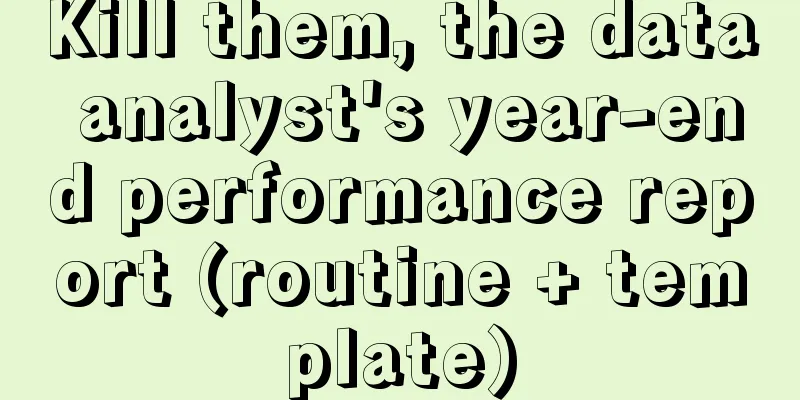Kill them, the data analyst's year-end performance report (routine + template)

It is the annual year-end summary + performance report session again. Many students asked: Is there a ready-made template to copy? Today it is really here. Considering that each student has a different temperament when doing performance report, some want to stand out, some just want to get the job done, and some have long been dissatisfied with the company and want to leave immediately. Therefore, we will provide several personalized versions today, and everyone can write according to their own needs. Version 1: Negative score rolling typeUsage scenario: When you want to be scolded by your boss. model essay:
Writing tips: Many students who do data analysis actually have no project experience, nor do they do serious modeling. They just do manual SQL and run a bunch of numbers every day. At this time, they feel like they are busy every day, but they don’t know what they are busy with. So they tend to write a few random sentences in a hurry. I was doing data analysis, but the report I wrote didn't even have any numbers. The whole report was filled with adjectives like "busy", "tired", "a lot", "a lot", and "really a lot". This kind of report is most likely to be criticized by the leader, and there is no benefit except being scolded. Everyone should take this as a warning. Version 2: Get it over withUsage scenario: Students who have no desires and just want to hand in their homework. model essay:
Writing tips: If you just want to get the job done, remember this sentence pattern: I + completed + XX task. Done! This can clearly and intuitively express to the boss: I have done the work assigned to me. In order to overcome the problem of version 1, we have to explain the question "What is this code for?" Therefore, it needs to be categorized. The five most common outputs of data analysis are: temporary data collection, reports, special reports, models, and data products. They can be written in five parts. Each task has four states: new creation, update, optimization, and iteration (deletion/merge), which can also be written separately. In this way, the seemingly chaotic daily work can be clearly classified. Some students complained, saying: I did the classification, and found that 90% of my work is updating reports, outputting reports in a fixed format day by day by day for 365 days... This is really worthless, and I can't write well! Yes, if the work is really just fixed updates, then it is really worthless. Give up the performance evaluation this year, and ask yourself more next year, why are you so content with the status quo and don't think about doing something to achieve results. Version 3: The icing on the cakeUsage scenario: Want to leave a good impression in front of the boss. model essay:
Writing tips: If you want to add icing on the cake, you can't just say: what work I did. Instead, you have to say: what value I created. Even if it's the same work, the leader is always more concerned about: who has the greater output. But data analysts are different from sales, operations, and product managers, and have unique writing styles. The biggest difference between data analysis and sales is that data analysis is a supporting position, which is used to boost sales. So you can’t brag like sales: I earned 10 million for the company! The biggest difference between data analysis and operations is that data analysis is a supporting position, which is not as public as operations, where you can brag: Our activities attracted 100 million clicks and drove DAU growth by 30%. As a supportive position, if you shout: I made 10 million for the company, sales and operations will jump up and say: You made nothing without us. If you shout: I wrote 100,000 lines of code, everyone will scold you: "If you don't write, who will? If you don't write, get out." Therefore, if data analysts want to demonstrate their achievements, the key is to gain recognition from external departments. Therefore, we can talk about how to help, how to empower, and how to assist, for example:
Please note that these four points have a certain order: support ≥ risk avoidance ≥ enhancement ≥ suggestion. Because support is the most rigid, it is a help that no one can argue with. For example, if the leader wants to see the real-time transaction amount on Double Eleven, then a large data screen must be made. Otherwise, there is nothing to see. The credit belongs only to the data. Both hedging and enhancement can be reflected in performance, but the recognition of hedging is higher than that of enhancement. It is like teaching a student who scored 60 points to 90 points is difficult, but it is easy to point out that "it is that idiot who scored 0 points and dragged down the whole class!" Point out the problems that the business has not discovered, cut two stupid projects, and the ROI will increase immediately. In fact, this is also a common method used by the finance, audit and other departments to seek credit in front of the leaders (interestingly, they also draw the conclusion of "controlling XX expenses" based on data analysis). Enhanced products are difficult to implement and require business support, such as precision marketing, product recommendations, and demand testing. Although it seems that a lot of data analysis work has been done, coupons that are separated from operations are not that effective. So it is easy to argue. As for suggestions, who knows whether people will listen to your suggestions. Even if they do, there is still a long way to go between a suggestion and the final business output. Costs, implementation plans, system development, page design, product selection, division of labor and cooperation, customer service docking, each link is more important than a suggestion. Therefore, unless the business department takes the initiative to say, "This is a good suggestion," data analysts generally will not take the initiative to show off their so-called suggestions. Seeing this, another student said: Teacher, I usually never ask what the data is used for. I just run the numbers and hand it in. I don’t know how to write it here. Well, if this is the case, I will give up this year’s assessment. Remember not to do this next year. Normally, Teacher Chen is always chattering, and for each analysis unit he will talk about "the business can be combined in this way here, and the value can be output in that way there." He is just preparing for this day. When you look at the analysis methods in the future, don't just worry about how to calculate the numbers, but pay more attention to the implementation scenarios. Another student asked: "Teacher, since we need other departments to approve it, what should we do if they don't approve it?" In essence, the solution to the problem is to formally establish a project and solve the problem through the project. In addition to establishing a project, there is another operational detail, which is to take more photos and send more emails. For example, the business leader replied by email: "Great analysis! Good!" I took a screenshot as evidence. For example, at the Double Eleven celebration party, the big bosses took a group photo in front of the data screen, good, take a photo as evidence. For example, when sharing data at the department meeting, good, take a photo as evidence! In short, keep more evidence in normal times to prevent people from forgetting to pull up their pants and not recognizing them afterwards. Version 4: The Needle Hidden in CottonUse scenario: job hunting or showing off in front of a big boss model essay:
Writing points: There is only one difference between this and version 3, that is, I gave myself a label. And this label is intuitive and understandable. Some students may be curious: such a small action can have a big effect. Yes! Of course it does! The last student who gave himself a label of "Big Screen Expert" has a monthly salary of over 30,000 in just 24 years, hahahaha. Because the job report is likely to be reported to the superior (such as the director of a large department or CTO, COO), there is a problem here: how to make laymen understand insiders as quickly as possible. This is the core problem that data analysts must solve when they develop from low-level to high-level. Because in the eyes of outsiders, you are just a person who can do numbers and doesn't know anything about the industry. It is difficult for them to understand the difference between working with Hadoop and using an abacus, so it is difficult for them to resonate with you and recognize your value. Moreover, this is in front of the boss, who has many subordinates and very little time, so you must show your value in the shortest possible time and establish an emotional connection with the boss. Labels are the best tool. The way to label is to start with something that is closest to the boss, such as a spreadsheet, a big screen, or a report. First, give the boss a label that is close to life, so that he can recall it, and then list the numbers. This way, you can quickly establish an impression, and with data support, you appear down-to-earth, and the effect is very good. This trick is also very useful in interviews. During an interview, you usually have to face HR, the direct supervisor of the hiring department, the superior supervisor of the hiring department, and the big boss. In most cases, only the direct supervisor understands the specific business, and other people don’t understand it at all and don’t care much (especially HR, these liberal arts students are the ones who write spss and python together in the recruitment requirements). Therefore, using a few tags to quickly establish an impression, it is easy to stand out. The above is the serial routine of the year-end performance report. After reading it, you will find that the performance report is just a piece of paper. What really proves oneself is the accumulation of a lot of work in daily life + careful summary and analysis. We say that we should keep our heads down when walking, but also look up at the sky. That's it. We work to earn some money, and we should do more work that makes others happy to better reflect our value. If we want to be happy, it's better to spend money. Many students may feel discouraged after reading this, thinking that they did not do a good job this year and accumulated too little. It’s okay, at least everyone now sees the direction to work hard, and we will continue to work hard together next year. Come on! Author: Down-to-earth Teacher Chen WeChat public account: Down-to-earth Teacher Chen |
<<: A substitute has come, is the big name dead?
>>: Why do reaction videos become popular when foreigners listen to Chinese music?
Recommend
Who will take over the goods?
This article deeply explores how the one-stop logi...
3 episodes have been viewed over 80 million times, and game companies are bravely entering the short drama track
Recently, many well-known game companies, includin...
My copywriting lost to the folk master again
Have you ever paid attention to the copywriting ar...
January's marketing cases are out, giving you a burst of inspiration
January is coming quietly. In this month with a st...
How do I fill in the order number for an Amazon order? Why is there no information on the Amazon order number?
For merchants, order packaging and shipping is a b...
How does Amazon offer free shipping? Does Amazon offer shipping insurance?
As one of the world's largest e-commerce platf...
Operations = miscellaneous tasks, solving one problem or a category of problems?
Those who work in operations may all go through a ...
Video accounts severely crack down on false advertising by merchants and influencers
Recently, WeChat officially released the "Not...
Can Shopee live broadcasts be recorded? Does it have any impact?
There are many ways to open and operate a store on...
Which countries are listed in Amazon Asia? How are the fees charged?
On the Amazon platform, you can choose a site and ...
How to upload store avatar on Shopee? How to upload products on Shopee?
A well-decorated store will give people a bright f...
Does Alibaba International Station use Qianniu? What functions does it have?
Everyone knows Alibaba. After opening a store on A...
New and old players are accelerating forward, how do new ways of playing on social platforms "impact" local life?
Marketing through social media is a new trend in t...
Is it necessary to pay a deposit for Shopee activities? Detailed analysis
Most e-commerce platforms require merchants to pay...
Can Amazon's overage inventory be returned to overseas warehouses? What will happen?
The overage inventory on Amazon needs to be handle...









